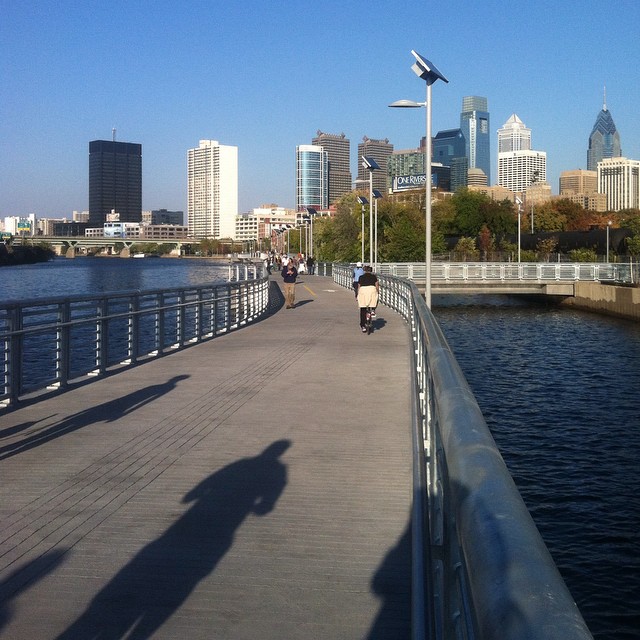How The Circuit Can Work for Philadelphia’s Commuters

June is such a happy month for so many reasons. It marks warmer weather and sunnier days, which sets the perfect tone considering it’s also National Trails Month. There’s nothing quite like spending a beautiful summer day outdoors running, walking, or biking on any of the nation’s 60,000 miles of trails that exist throughout all 50 states. Right here in the Greater Philadelphia area, The Circuit is the main trail network. Eventually stretching 750 miles, The Circuit Trails are comprised of many existing trails (and many proposed trails coming in the future) for everyone to enjoy.
The Circuit will connect communities in and around the Philadelphia area to environmental destinations, which will provide endless recreational opportunities. However, as National Trails Month winds down, we thought commuters should know that these trails can work for their busy 9 to 5 schedule, too – by connecting people to public transportation.
The region’s public transit network is crucial for Center City to be able to provide 42% of all jobs in Philadelphia. According to Center City Reports: Getting to Work: Transit, Density & Opportunity, if all 295,000 downtown employees drove into work every day, Center City would need a parking lot spanning 2.6 miles. This is larger than William Penn’s original plan for the city, and would leave little space for the diverse array of downtown employment opportunities that exist today.
Over the last few decades, Center City has developed into the prosperous, fast paced business district that it is today, containing a whopping 295,000 jobs. With help from the city’s existing public transit network, the nearly 245,000 workers who commute in from outside Philadelphia have the option to enjoy a relaxing train ride instead of sitting in stressful bumper to bumper highway traffic.
While it’s easy for some commuters to hop on public transit out of Center City to get home after a long day, it’s not as easy for some to use public transit to get to and from work. Many train stations are geographically isolated from residential areas, making it nearly impossible for commuters to safely access them from their homes without the use of a car.
The Delaware Valley Regional Planning Commission (DVRPC) works to identify candidate SEPTA stations for bicycle friendly investments using a screening tool called RideScore, which works into SEPTA’s Cycle-Transit Plan. RideScore helps SEPTA, trail advocacy groups, and surrounding municipalities understand each station’s characteristics that influence how bike friendly it is. One way SEPTA can use this information is to prioritize bicycle rack installation at specific stations to strengthen bicycle and transit connectivity throughout the region.
Manayunk Station on the Manayunk/Norristown Line, for example, received an average RideScore of 9.3 out of 10. This is in part due to very high “Connectivity” (walkability), “Circuit Proximity,” and “Near Bicycle Facility” (on-road facilities, such as bike lanes) scores. Stations with high RideScores, like Manayunk, make it easier than ever for commuters to safely bike from home on the trail, park their bicycle, and then hop on the train to work.
Not only do trails make it easier for commuters to access public transit without the use of a car, they also offer a variety of other benefits, including:
Increased Workplace Productivity
Engaging in moderate exercise balances the brain’s neurotransmitters, which control mental activity linked to mood, attention, motivation, and the ability to retain information. Bicycling or briskly walking from home to public transit in the morning can help the brain and body cope better with stress throughout the day, which is particularly good for commuters who work in high-pressure environments.
Saved Time
According to INRIX, a leading traffic intelligence provider, the worst bottleneck in the Greater Philadelphia area is the Schuylkill Expressway eastbound at the South Street/Exit 346, where the average car speed when this area is congested is a slow 18.9 mph. By using trails in conjunction with public transit, commuters will avoid wasting time sitting in rush hour traffic.
Saved Money
It’s estimated that the average Philadelphia driver spends $2,300 in wasted time, general car maintenance, and gasoline yearly. In comparison, the average annual operating cost of a bicycle is only $308, and walking is free! Also, many employers offer RideECO, which allows employees to save money by using pre-tax dollars to pay for their commute. Using the region’s multi-use trails on foot or on bike to access public transit will save commuters more money to spend on things like happy hours and vacations.
With all of these benefits, you might want to check out existing and proposed trails in your community on The Circuit’s Trail Finder. And if you are interested in combining cycling with public transportation as part of your commute or just for discovering new places to recreate, check out GoPhillyGo.org. Hopefully by now you’ve celebrated National Trails Month, but if not – or you want to continue the celebration all summer – consider working a trail into your public transit commute!
If you have any questions, please contact Alyssa Geoghan, Sustainable Transportation Outreach Coordinator, by calling 215-567-4004 ext. 120 or emailing ageoghan@cleanair.org.

